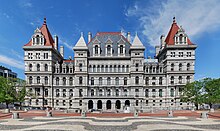Legislature of New York
| New York State Legislature | |
|---|---|
 |
|
| Type | |
| Type | |
| Houses |
Senate Assembly |
| Leadership | |
| Structure | |
| Seats | 213 |
 |
|
|
Political groups
|
Majority caucus (104)
Minority caucus (37)
Vacant (9)
|
 |
|
|
Political groups
|
Majority caucus (32) Minority caucus (29)
Vacant (2)
|
| Salary | $79,000 |
| Elections | |
|
Last election
|
November 8, 2016 |
|
Next election
|
November 6, 2018 |
| Meeting place | |
 |
|
| New York State Capitol, Albany | |
| Website | |
|
public www |
|
Majority caucus (104)
Minority caucus (37)
Vacant (9)
Majority caucus (32)
Minority caucus (29)
Vacant (2)
New York State Legislature are the two houses that act as the state legislature of the U.S. state of New York. The New York Constitution does not designate an official term for the two houses together. It says only that "legislative power is vested in the senate and assembly." The session laws are published in the official Laws of New York. The permanent laws of a general nature are codified in the Consolidated Laws of New York. The legislature is seated at the New York State Capitol in Albany.
Legislative elections are held in November of every even-numbered year. Both Assembly members and Senators serve two-year terms.
In order to be a member of either house, one must be a citizen of the United States, a resident of the state of New York for at least five years, and a resident of the district for at least one year prior to election.
The Assembly consists of 150 members; they are each chosen from a single-member district. The Senate, in accordance with the New York Constitution, varies in its number of members, but currently has 63. Senate districts are currently between two and three times more populous than Assembly districts. As of 2009 the New York State Legislature has 2700 employees, more than any other state legislature except for the Pennsylvania General Assembly.
The Assembly is headed by the Speaker, while the Senate is headed by the President, a post held ex officio by the State Lieutenant Governor. The Lieutenant Governor, as President of the Senate, has only a tie-breaking "casting vote". More often, the Senate is presided over by the Temporary President or by a senator of the Majority Leader's choosing.
...
Wikipedia
